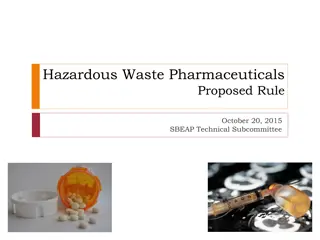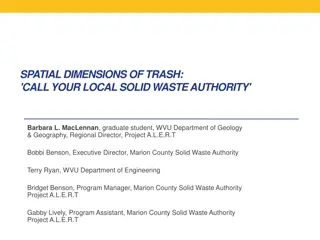Effective On-Site Handling, Storage, and Processing of Solid Waste
On-site handling, storage, and processing of solid waste play a crucial role in public health protection, nuisance prevention, and waste management. The activities involve gathering, segregating, and compacting waste to reduce volume. Different methods are used based on the type of residential building, with considerations for container materials, location, and collection methods. Commercial and industrial facilities also have specific requirements for waste management. Proper container selection, maintenance, and cleaning are essential components for effective waste management practices on-site.
Download Presentation

Please find below an Image/Link to download the presentation.
The content on the website is provided AS IS for your information and personal use only. It may not be sold, licensed, or shared on other websites without obtaining consent from the author. Download presentation by click this link. If you encounter any issues during the download, it is possible that the publisher has removed the file from their server.
E N D
Presentation Transcript
On site handling, storage, and processing: These activities are of significant effect on: a) Public heath protection, control of flies, cockroaches. b) Nuisance prevention, odors, unsightliness. c) Subsequent functional elements: collection, final disposal. d) Public attitude; concerning the operation of the system. On site handling: It refers to the a activities (at the generation source) associated with the handling of S.W until they are placed in the storage container ready for collection, it also include the move of the loaded container to the collection point and the return of empty container to where it is stored. Handling process differ with generation source residential, commercial, industrial . Residential dwelling can be classified as Low rise 4 stories Medium rise 4-7 stories High rise 7 stories In low rise dwelling, the residents or tenant are responsible for gathering S.W generated in different places of the dwelling and place then in the storage container, segregation or separation of certain articles of value compaction of S.W to reduce volume, incineration of certain components, grinding of garbage in kitchen grinders if available.
-In medium and height rise residential building the handling and storage of S.W is more complicated and associated with certain problems. The following, method can be used -S.W are picked up by building maintenances personal to the basemen or service area . - Waste are taken to the basement or service area by tenants. -Waste usually bagged and wrapped and placed in the vertical chute of the building through the floors opening. Methods of volume reduction. - Grinding of S.W. - Mechanical compaction. - Incineration. - Separation and recycle of S.W On site storage: The following factors to be considered 1. Type of container to be used. 2. The container location. 3. Public health and aesthetic. 4. Collection Method to be used.
Container Requirements 1.Must be strong enough and easy to clean. 2.Leak proof, five proof, not subject to corrosion, with light lid seal. 3. Not too large and not to heavy. 4. Should have handle if they must be carried. The choice of container Material depends on the preference of the individualhomeowner. Container Material 1. Galvanized steel, (30 gal capacity) -Durable, fire proof, heavy, subject to corrosion, noisy when emptied. 2. Plastic. Low weigh, tough at normal temp, smooth surface and variable color, impermeable to moisture, less noise during collection, sharp edges. 3. Paper bags: for domestic collection. Easy to handle during collection, not fire proof. Single use (disposable), Subject to be torn and affected by moisture easily stretched by sharp edges. Card board boxes same as paper bags.
4. Plastic bags for domestic collection. Easy to handle and collect, Single use (disposable, Easy to be of streched by animals and by sharp article, Can be water tight not leaky, not fire proof. Common contains (Communal storage container) Large container designed to store wastes from a group of dwelling, the container should have easy access to a near by street. They usually with rollers to aid moving it to the collection vehicle. Container location: Containers used in low rise building are placed a. At the sides or near of the house. b. In alleys, where alley collection is used. c. In the garage. d. Some common location designated for that purpose. Commercial and Industrial facilities: To be located in a location In suitable as service access. Container are advised to be put on concrete pad and roofe covered or enclosed by wooden or chicken wirefence. Container should be cleaned with water and disinfected after being emptied and any waste spill should be cleaned very soon.
On site processing of S.W Processing methods on site are used to: 1.Reduce volume and quantity such as grinding, compaction, incineration. 2.Alter the physical from, shredding, grinding. 3.Recover usable Material ( paper, plastic, aluminum, can, glass). Grinding: This process gained such wide acceptance in the last 50 years specially in new residential building where dwelling are equipped with grinders. It more used in progress country. It is used for grinding garbage (food waste) to render them passing and transporting in sewers and then treated in sewage treatment plant (as organic component). Garbage grinding has an impact on the quality of S.W collected, less density less moisture content, less putriscible and odors, less attraction to rates, flies, and insects. It is impact on collection activities affect the collection frequency and reduce leachate and odor, for incineration more acceptable. In sanitary L.f less problems also. It may cause some problems to sewarage system settling and cloggin of sewer, add more organic to existing sewage treat works.
Compaction: Compaction of S.W is used mainly to reduce volume to affect collection and disposal activities on site it help in reducing storage container capacity ( No. of container and volumes). Compaction can be accomplished manually or mechanically. -Small compactors designed for home use with compaction ratio of loose paper and cardboard up to 70 % reduction in volume. -Mechanical compactors (Stationary or portable) available can be used in multi story building in basements or service areas to compact S.W in the containers. -Compaction may have negative effects on subsequent process operation such as in municipal incinerators where S.W (compacted) must be broken up before fed into incinerator. -Waste become saturated with moisture presents in garbage specially paper and cardboard where their recovery may become no feasible. Incineration: Burning of combustible material in fire places and burning rubbish in crude backyard incinerators. The use of home incinerator may reduced both putriscible components and the total volume of S.W. Incineration on site may be a source of fire hazard, and also it is a source of air pollution.
In high rise building, incinerators are of two types: Flue fed : in which S.W are charged through doors on each floor directly into the refractory flue, the bottom open directly in to the top of the furnace combustion chamber. Chute fed types: waste disposed in to the chute from each floor collected into the basement hopper, and then transported to the furnace of the incinerator. Compositing: considered as a mean of recycling organic matter reduction in volume, altering physical and chemical composition, through which production of useful by product used as organic fertilizer. Shredding of S.W : are alteration processing operations used both in conjunction with the previous methods for reducing the volume of waste. On site handing, storage and processing ( specialcases) 1. Hospital wastes: segregation of contaminated wastes and non contaminated wastes. Contaminated wastes in hospitals include Blood, syringes, needles, urine and pathological. These should be picked up and stored in special containers and location, then disposed by high temperature incinerators and the residue can be collected with other wastes.
2. Hard services areas: densely populated area usually in old parts of the city when narrowstreets. Small Vehicles for collection of wastes from different dwellings and move it to a transfer area a close to broad street where a roll-off bins in which waste are loaded weighting transportation or loaded in collection vehicles to L.F site. The solutions to prevents over flow are: 1.Use more container. 2.Use larger volume container. (not too heavy to be handled). 3.Deliver wastes to disposal sits more often or more collection frequency. 4.Use compactors to squeeze more wastes in to a given volume.























